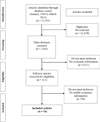Legislations and policies to expand mental health and substance abuse benefits in health insurance plans: a community guide systematic economic review
- PMID: 25862203
- PMCID: PMC4682360
Legislations and policies to expand mental health and substance abuse benefits in health insurance plans: a community guide systematic economic review
Abstract
Background: Health insurance plans have historically limited the benefits for mental health and substance abuse (MH/SA) services compared to benefits for physical health services. In recent years, legislative and policy initiatives in the U.S. have been taken to expand MH/SA health insurance benefits and achieve parity with physical health benefits. The relevance of these legislations for international audiences is also explored, particularly for the European context.
Aims of the study: This paper reviews the evidence of costs and economic benefits of legislative or policy interventions to expand MH/SA health insurance benefits in the U.S. The objectives are to assess the economic value of the interventions by comparing societal cost to societal benefits, and to determine impact on costs to insurance plans resulting from expansion of these benefits.
Methods: The search for economic evidence covered literature published from January 1950 to March 2011 and included evaluations of federal and state laws or rules that expanded MH/SA benefits as well as voluntary actions by large employers. Two economists screened and abstracted the economic evidence of MH/SA benefits legislation based on standard economic and actuarial concepts and methods.
Results: The economic review included 12 studies: eleven provided evidence on cost impact to health plans, and one estimated the effect on suicides. There was insufficient evidence to determine if the intervention was cost-effective or cost-saving. However, the evidence indicates that MH/SA benefits expansion did not lead to any substantial increase in costs to insurance plans, measured as a percentage of insurance premiums.
Discussion and limitations: This review is unable to determine the overall economic value of policies that expanded MH/SA insurance benefits due to lack of cost-effectiveness and cost-benefit studies, predominantly due to the lack of evaluations of morbidity and mortality outcomes. This may be remedied in time when long-term MH/SA patient-level data becomes available to researchers. A limitation of this review is that legislations considered here have been superseded by recent legislations that have stronger and broader impacts on MH/SA benefits within private and public insurance: Mental Health Parity and Addiction Equity Act of 2008 (MHPAEA) and the Patient Protection and Affordable Care Act of 2010 (ACA).
Implications for future research: Economic assessments over the long term such as cost per QALY saved and cost-benefit will be feasible as more data becomes available from plans that implemented recent expansions of MH/SA benefits. Results from these evaluations will allow a better estimate of the economic impact of the interventions from a societal perspective. Future research should also evaluate the more downstream effects on business decisions about labor, such as effects on hiring, retention, and the offer of health benefits as part of an employee compensation package. Finally, the economic effect of the far reaching ACA of 2010 on mental health and substance abuse prevalence and care is also a subject for future research.
Similar articles
-
What Does Mental Health Parity Really Mean for the Care of People with Serious Mental Illness?Psychiatr Clin North Am. 2016 Jun;39(2):331-42. doi: 10.1016/j.psc.2016.01.010. Epub 2016 Mar 8. Psychiatr Clin North Am. 2016. PMID: 27216906 Review.
-
Behavioral health parity and the Affordable Care Act.J Soc Work Disabil Rehabil. 2014;13(1-2):31-43. doi: 10.1080/1536710X.2013.870512. J Soc Work Disabil Rehabil. 2014. PMID: 24483783 Free PMC article.
-
The Mental Health Parity and Addiction Equity Act (MHPAEA) Evaluation Study: Impact on Quantitative Treatment Limits.Psychiatr Serv. 2017 May 1;68(5):435-442. doi: 10.1176/appi.ps.201600110. Epub 2016 Dec 15. Psychiatr Serv. 2017. PMID: 27974003 Free PMC article.
-
After parity--what's next.Health Aff (Millwood). 2009 May-Jun;28(3):660-2. doi: 10.1377/hlthaff.28.3.660. Health Aff (Millwood). 2009. PMID: 19414871
-
Mental health and substance abuse benefits in carve-out plans and the Mental Health Parity Act of 1996.J Health Care Finance. 1998 Spring;24(3):82-92. J Health Care Finance. 1998. PMID: 9502060 Review.
Cited by
-
State Legislators' Support for Behavioral Health Parity Laws: The Influence of Mutable and Fixed Factors at Multiple Levels.Milbank Q. 2019 Dec;97(4):1200-1232. doi: 10.1111/1468-0009.12431. Epub 2019 Nov 11. Milbank Q. 2019. PMID: 31710152 Free PMC article.
-
A Scan of CDC-Authored Articles on Legal Epidemiology, 2011-2015.Public Health Rep. 2016 Nov;131(6):809-815. doi: 10.1177/0033354916669497. Epub 2016 Oct 19. Public Health Rep. 2016. PMID: 28123227 Free PMC article.
-
Factors associated with state legislators' support for opioid use disorder parity laws.Int J Drug Policy. 2020 Aug;82:102792. doi: 10.1016/j.drugpo.2020.102792. Epub 2020 Jun 12. Int J Drug Policy. 2020. PMID: 32540516 Free PMC article.
-
Association Between State Medicaid Eligibility Thresholds and Deaths Due to Substance Use Disorders.JAMA Netw Open. 2019 Apr 5;2(4):e193056. doi: 10.1001/jamanetworkopen.2019.3056. JAMA Netw Open. 2019. PMID: 31026034 Free PMC article.
-
Hepatitis B vaccination in Iran: Historical policies and programs.J Prev Med Hyg. 2022 Dec 31;63(4):E618-E624. doi: 10.15167/2421-4248/jpmh2022.63.4.2731. eCollection 2022 Dec. J Prev Med Hyg. 2022. PMID: 36891002 Free PMC article.
References
-
- Buck JA, Umland B. Covering mental health and substance abuse services. Health Affairs. 1997;16(4):120–126. - PubMed
-
- Jensen GA, Rost K, Burton RP, Bulycheva M. Mental health insurance in the 1990s: are employers offering less to more. Health Affairs. 1998;17(3):201–208. - PubMed
-
- U.S. Department of Health and Human Services. Mental health: A report of the Surgeon General. Rockville, MD: National Institute of Mental Health; 1999.
-
- Frank RG, Koyanagi C, McGuire TG. The politics and economics of mental health 'parity' laws. Health Affairs. 1997;16(4):108–119. - PubMed
-
- Sing M, Hill S, Smolkin S, Heiser N. The costs and effects of parity for mental health and substance abuse insurance benefits. US Department of Health and Human Services, Public Health Service, Substance Abuse and Mental Health Services Administration; 1998.
Publication types
MeSH terms
Grants and funding
LinkOut - more resources
Full Text Sources
Medical
Research Materials


